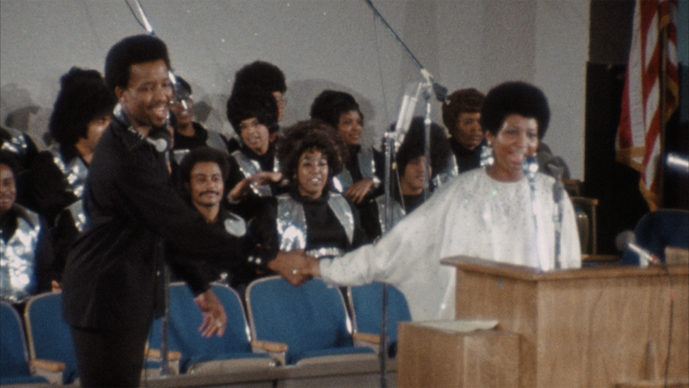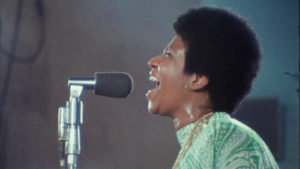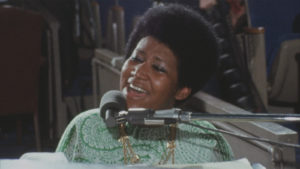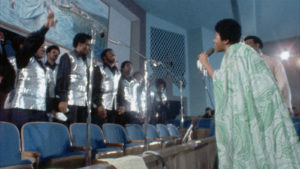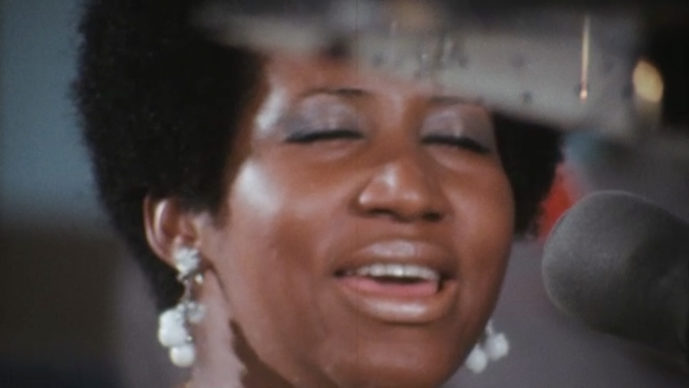Click here to print
A Diva’s Amazing Grace, A Filmmaker’s Persistence
posted June 13, 2019
In January 1972, a 29-year-old Aretha Franklin, already renowned in soul behind five Grammys and 11 No. 1 singles on the Billboard charts for hits like “I Never Loved a Man (The Way I Love You),” “Chain of Fools,” and Otis Redding’s “Respect,” returned to her roots. She performed two evenings of riveting gospel worship in the run-down New Temple Missionary Baptist Church in Watts, Los Angeles.
The soaring celebrations of faith became legendary moments in popular-music history.
They also produced a long, confused saga of film loss and retrieval.
Parts of the recitals were issued on an acclaimed double album, Amazing Grace, which remains the best-selling gospel recording ever; long ago it was certified double platinum for topping two million in sales. But even as the album garnered vast praise, until recent times few people knew that the concerts were filmed. And not just filmed: behind the cameras, shuffling about among the worshippers, had been a crew led by later Academy Award-winning director Sydney Pollack, already a Hollywood staple for several films including 1969’s They Shoot Horses, Don’t They.
Pollack was there to capture not only Franklin, but also the Rev. James Cleveland and his celebrated Southern California Community Choir. With them was a band of Atlantic Records aces including drummers’ drummer Bernard Purdie, protean bassist Chuck Rainey, and equally versatile guitarist Cornell Dupree along with gospel diva and Franklin mentor Clara Ward, clad in fur and nearing the end of her short life.
Franklin performed gospel classics by Ward as well as Thomas Dorsey, and also gospelized contemporary material such as Marvin Gaye’s “Wholy Holy” from the just-out What’s Going On and a version of Carole King’s “You’ve Got a Friend” as a homage to Martin Luther King, Jr.
The singer’s father — “Million Dollar Voice” Baptist preacher, C. L. Franklin — was in the humble church, too, on the second night. As his daughter, dressed in green paisley cape gown, sang the traditional “Never Grow Old,” he rose to wipe sweat from her face.
Of course, those who were in attendance knew of the presence of a film crew — Rev. Cleveland coached them in how to act in front of the cameras. But the filming didn’t become common knowledge – on the contrary, it came to be lost in time because for many years no feature film was ever publicly released.
The reasons for that began with a simple but startling slip-up in production: Pollack and his colleagues omitted to bring along a “clapperboard” that would permit them to match film prints to audio recordings in post-production. They came away from a hectic two sessions of shooting with many sections of audio and sound recordings, but matching them, let alone syncing them, quickly proved a daunting challenge.
Eventually the prints were archived at Warner Bros. They remained there until 2007 when film producer Alan Elliott bought them (mortgaging his home to raise the do-re-mi). He had the blessing of Pollack, who would die the following year but who had earlier paved the way for Elliott to make the purchase.
By 2011 Elliott was able to plan an opening for Amazing Grace, his 89-minute edited package of the material. But it would be another seven years before Amazing Grace had its premiere.
Its labored progress towards public presentation was due to various holdups. There was the syncing issue, but even when Elliott had solved that, another remained: that Aretha Franklin objected to Elliott’s releasing the film, at all. She sued him for appropriating her likeness without permission, and managed to delay release.
In 2015, Elliott tried again, planning to debut Amazing Grace at a variety of North American film festivals. Just hours before its intended premiere at the Telluride Film Festival, Franklin once more called in her lawyers. They pleaded again that Elliott was releasing the film without Franklin’s permission.
She got another injunction even though Elliott was by then in possession of the 1968 contract in which Franklin had signed over to Atlantic and Warner Brothers her rights to film footage of her; Elliott had bought the Amazing Grace footage, so figured he was within his rights.
Nonetheless, Franklin’s opposition kept the film out of the Telluride festival that year, and the following year, 2016, too.
One might have thought that Aretha Franklin‘s wishes would guide decisions about release, but of course such is often not the way. Other interests and motivations win the day, not always graciously. In the case of Amazing Grace, the holdup in 2015 reportedly was that Franklin understandably wanted to be part of any profit-taking.
Strengthening that theory was that the Queen of Soul had already told the Detroit Free Press in 2015 that she “loved” the film upon seeing a DVD of it that Elliott had provided.
Then she became gravely ill, and in August 2018 died. Quickly, 46 years after the Amazing Grace concerts, Franklin’s estate reached an agreement with Elliott and the film premiered in November at the DOC NYC festival in time to qualify for Oscars nomination. Its Los Angeles premiere took place in April 2019 at the New Temple Missionary church in Watts where the 1972 performances had taken place.
As Sabrina V. Owens, the late star’s niece and executor of her estate, told Variety magazine, Elliott had earlier presented the film to about 50 members of the Franklin family at the African American Museum in Detroit, “and we absolutely love it.”
In fact, she said, her aunt had told her she loved it, too, but had not revealed what her opposition to its release really was.
Owens called Elliott’s film “an opportunity for those individuals who had not experienced [Aretha Franklin] in a gospel context to see how diverse her music is.” And she said that in the family’s view, the film’s merits include that it shows the singer “very youthful, very shy, and her voice is just beautiful throughout, at an age when her voice was absolutely crystal-clear and very pure.”
Owens, who had been a friend of Elliott’s for years by the time she invited him to the singer’s funeral in Detroit in late August, 2018, added that her aunt’s death seemed a good time for the film’s release, because “people want something in a very spiritual mode.”
As the film continues to do the rounds of festivals and cinemas the world over, its many points of interest include not only Franklin’s stellar performances and arresting presence, but also non-performing cameos by Mick Jagger and Charlie Watts — they had dropped by: such were the times, and they were in town working on Exile on Main St. — and Sydney Pollack, himself. But for moving-image archivists, a good deal of the interest may be in how Elliott, who is far from alone in calling the recordings Franklin’s “crowning achievement,” managed to navigate to the point of producing the film, at all.
Alan Elliott Reveals How He Did It
Alan Elliott has by now told his side of the wrangle in a variety of settings. Last week [Friday, 7 June 2019] he related the details of the technical and legal challenges in an instalment of Stop Everything!, a program on Radio National of the Australian Broadcasting Corporation, ahead of the film’s Australian premiere at the Sydney Film Festival.
Speaking from Los Angeles, Elliott said his own history of fascination with Aretha Franklin dates back to his childhood. His father was the musical director for the Grammy Awards for their first 31 years, and when Elliott was eight years old, in 1972, his father bought home the Amazing Grace double LP. The young Elliott heard it, was captivated, and ever since then the album has been, for him, a kind of musical “comfort food for our souls,” he said.
When, as an adult, he first heard that there was film to match the music, a kind of “cognitive dissonance” set in, he said.
That occurred when he went to work as a producer at Atlantic Records and happened one day to be talking to Jerry Wexler, the producer of the Amazing Grace audio release. In passing, Wexler idly said “we filmed it.”
Sydney Pollack had filmed the concerts!
[Elliott gave a little more detail to Rolling Stone in a November 2018 interview: Wexler had said to him, “‘You heard Amazing Grace, right?’ … “I said it was my favorite record. He was a gruff fella, and he said, ‘We filmed it. We made the record and the film company made the film but fucked it up. I brought home a great record — I don’t know what those other guys did.’”
Elliott told Stop Everything!: “It just didn’t make any sense as to how the most famous gospel record ever made, with one of the most important film directors in the history of cinema, was not seen. And so that just became a cognitive dissonance that evidently I was tasked with cleaning up.”
He described what he had learned about the long delay. Warner Bros. had become interested in making a film of the concerts because in 1970 they had bought the rights to film the Woodstock music festival and did so well with them that they hatched a plan to become one large film, television, and music corporation.
Woodstock, and its audio and film packages, had changed the landscape of how an entertainment company like Warner Bros. could conceive of itself. It had bought the film rights for $100,000 and it had made them $18-million.
With Franklin’s Watts concerts, Elliott said, “they were looking to replicate that sort of synergy across the board, from film company to the record company, and this seemed to make sense. But…it didn’t.”
Warner Bros. hired Pollack, but he was not their first choice. Jim Signorelli had been — he would go on to work for many years as a segment director for Saturday Night Live, creating its popular mock commercials.
As already noted, when Pollack took his crew to the concerts, they proficiently recorded the Queen of Soul moving about the church, shifting from a lectern to a Steinway piano and back again, sweating in the stifling space while delivering timeless renditions of such gospel classics as “Amazing Grace” and “You’ve Got a Friend in Jesus.”
Only problem: no one remembered to pack a clapperboard.
Elliott told Stop Everything!: “So they get back to the editing facility on the Monday and have thousands of pieces of film and no idea which songs they filmed, or where they start, or end.”
Worse, for Elliott, was that Pollack told him nothing about the syncing issue when he helped him to buy the film from Warner Bros.: “I didn’t know until after Sydney had passed away” in 2008 “and I was given all the materials. One day I found in a dossier a memo internally from Warner Bros. that said ‘We’ve hired choir director Alexander Hamilton as a lip reader.’ And that’s when I realized there must be some problems that hadn’t been reported, before” – not to him, at least.
An invoice from Hamilton stated a charge of $200 a week for a couple of months’ work. He had presumably been hired in part because he had directed the choir during the church recordings. In materials that accompanied the film and audio, Elliott also came upon a VHS tape with snatches of film. Hamilton had taken to trying to lip-sync the film to audio he was running on a tape recorder, but had managed to align only about 53 minutes of the almost 14 hours of footage the crew had shot, and not a single whole song.
Still, Elliott told the ABC, upon seeing the footage, he was relieved and excited by “the energy of this record that I had lived with for 35 years which then took on a whole different dimension.”
He added: “I’ll always remember going into a post-production facility in Burbank, Cal., and seeing it and seeing that everything that I thought was so special took on even more resonance and more meaning and more musicality than it had on the record.”
As Elliott told MovieMaker in April 2019, he got in touch with Deluxe Entertainment Services Group whose video and audio engineer Serge Perron expertly synced video and audio with newer, far snazzier methods than Hamilton had had access to. Elliott and Perron got further assistance from Jeff Buchanan, an editor for directors Michel Gondry and Spike Jonze, and the technical puzzle was solved. Highly regarded sound engineer and mixer Jimmy Douglass, who had mixed Franklin’s original double LP for Atlantic as a 22 year old before working in hip-hop as, for example, Timbaland’s go-to sound guy, then came on board to mix the film’s audio.
But still legal roadblocks remained, Elliott told the ABC. He said “Sydney Pollack, who was a very sweet man and a good friend,” not only never mentioned the syncing issue, he also helped a “mythos” to build that Franklin had never signed a contract.
But “then we found her contract.”
To try to sort the history out, he said, “I went to Aretha — I mean, through one of her 15 or so representatives — and I said we’d love to have her involved, and she didn’t want to be a part of it.
“Now, why didn’t she want to be a part of it? Well, that same year, 1972, Diana Ross got to make Lady Sings the Blues and was nominated for an Academy Award. And right after this, Barbara Streisand got to go make The Way We Were.” So, said Elliott, “Warner Bros., thinking they had lightning in a bottle with Woodstock, and were going to follow it up with Amazing Grace, had promised Aretha that they were going to make her a movie star. And it didn’t happen.
“And I’m not sure she ever really got over that. I often say, she’s not mad at a 7–year-old Alan Elliott; she’s probably still mad at Warner Bros., from 1972.”
Other hiccups occurred. For example, Elliott asked Franklin about adding a coda to the film: it would feature her and surviving band and choir members. Elliott said Franklin agreed to a $1-million, one-day deal, but Michel Gondry, who was the planned director, left to produce Green Hornet, and the idea died.
And, again, her failing health intervened, too: “When we went to her with the [1968] contract, what we didn’t find out until afterwards was that she had pancreatic cancer.”
He learned that confidentially from Franklin’s niece, “who is a very close friend and one of the producers on the movie. [She] said to me three, three and a half years ago at this point, she has pancreatic cancer, and I said ‘Well, I guess we can’t put the movie out.’”
He said he hardly can blame Franklin for being uneasy about the film, because she didn’t know him, at all. As he told Rolling Stone: “She’s the Queen of Soul, and the movie company fucks it up and sells it to this guy and she has no idea who he is and he’s making a movie.”
She tested his resolve by asking more and more – $5-million, at one point — for her OK. He countered by offering to have well-known songwriter Mike Stiller and even-better-known singer-songwriter Bill Withers write a song for her to sing in the film as a way to qualify her for an Oscar Best Song nomination.
Still, no dice. Elliott told the ABC: “We had an agreement for years that we weren’t going to put it out while she was alive; I didn’t want to fight her in court about her contract. And I understood that the movie, for a woman with pancreatic cancer… the last song of the movie is the first song she ever recorded. And in that way it’s sort of a eulogy and I didn’t want her in any way to expect to go out and do press, as sick as she was.
“So we just sort of put it on the back burner for three years, and the family and I kept in constant contact. And then when she passed, they invited me to the funeral, they invited me to come show the movie to everybody, to make sure that everybody in the family knew all the information, and liked the movie and approved of it, and so that’s how we proceeded.”
— Peter Monaghan
Printed from Moving Image Archive News: http://www.movingimagearchivenews.org
URL to article: http://www.movingimagearchivenews.org/a-divas-amazing-grace-a-filmmakers-persistence/
Click here to print
